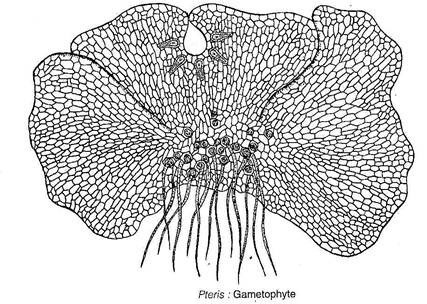Introduction:
Pteris is a genus of ferns that belongs to the family Pteridaceae. It consists of over 200 species and is widely distributed around the world. These ferns are known for their intricate leaf structure and unique reproductive structures. In this article, we will explore the structure and reproduction of Pteris ferns in detail.
Structure:
- The frond of the Pteris fern consists of a stalk known as a stipe and a leafy blade. The blade is further divided into several leaflets or pinnae, giving it a feathery appearance. The leaflets are arranged alternately on either side of the rachis. Each pinna is attached to the rachis by a small stalk known as the petiolule.
- The leaflets of Pteris ferns are typically elongated and have a lanceolate shape. The margins of the leaflets are serrated and have wavy edges. The leaflets have a smooth upper surface and numerous sporangia on the undersurface. The sporangia are arranged in linear clusters known as sori, which are covered by small, umbrella-like structures known as indusia.
- The leaves of Pteris ferns may be up to two feet in length, and the sori may be up to two inches in length, making them particularly large and easy to identify. In addition, they are often a wide range of colors, including green, blue, and silver, depending on the species.

Reproduction:
Pteris ferns reproduce through spores that are produced in the sporangia on the undersurface of the leaflets. The sporangia are arranged in sori, which are covered by indusia. The spores are typically small, and when they are mature, the indusia opens to release them.
The spores are dispersed by the wind and can germinate into gametophytes, which develop into mature plants. The gametophytes of Pteris ferns are small and grow close to the soil surface. They produce antheridia, which contain male gametes, and archegonia, which contain female gametes.
Fertilization occurs when the male gametes swim towards the female gametes and fuse to form a zygote. The zygote develops into a young sporophyte, which eventually grows into an adult fern plant with mature spores.
Pteris ferns can also reproduce asexually through the formation of bulbils or vegetative buds. These are small structures that form on the leaves or stems of the plant and can detach to grow into new plants.
Ecology:
Pteris ferns are adapted to a wide range of habitats, including forests, swamps, meadows, and rocky cliffs. They are particularly common in tropical and subtropical regions but can also be found in temperate zones.
Some species of Pteris ferns are invasive and can become problematic in areas where they are introduced. For example, Pteris vittata, also known as the Chinese brake fern, is a highly invasive species in many parts of the world.
Uses:
Pteris ferns have several uses in traditional medicine and horticulture. Some species have been used for their medicinal properties, particularly for the treatment of skin diseases. Pteris cretica is an example of a species that has been used in traditional medicine.
Pteris ferns are also popular in horticulture because of their unique leaf structures and easy-to-grow nature. They are often used in landscapes and gardens to add a tropical or exotic flavor.
Conclusion:
Pteris ferns are a diverse group of ferns that are widely distributed around the world. They are known for their intricate leaf structure and unique reproductive structures. These ferns reproduce through spores that are produced in sporangia on the undersurface of the leaflets and can also reproduce asexually through bulbils or vegetative buds. Pteris ferns have several uses in traditional medicine and horticulture and are adapted to a wide range of habitats.
